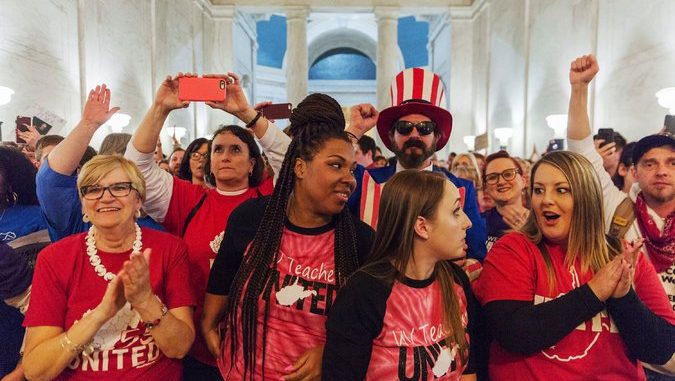
On Thursday, February 22, teachers in two of West Virginia’s fifty-five counties walked out. By Monday, March 1, schools shut down state-wide. Thousands of teachers and staff rallied in Charleston demanding raises and protesting increases in healthcare premiums. Eight days later, the Republican-dominated state government capitulated, granting a 5% raise to all state employees. The government also agreed to delay cuts to healthcare benefits for 16 months. This strike is not just a victory for the West Virginia teachers and state workers, it is an example for all of us and one that could quickly spread.
The starting pay for teachers in WV is $34,000 and staff make even less. Some teachers are on food stamps and many more have additional part-time jobs. School employees haven’t had a raise in four years and healthcare costs have soared. The strike began after the West Virginia legislature passed a budget with only a 2% wage increase and a 1% raise in the following two years. Also, the budget included measures to increase teachers’ healthcare charges by $300 a month in 2019. As one striker put it ,“I only clear $1300 every two weeks and they’re wanting to take $300 more away from me. But they tell me that’s okay because we’re going to give you a 1% pay raise. That equals out to 88¢ every two days.”
The teachers’ strike came after months of organizing by teachers independent of their union officials. In the beginning, some teachers set up a Facebook group to discuss how to organize against the politicians and timid union officials. Eventually 20,000 teachers and staff joined the Facebook group and teams of teachers began to reach out across school district boundaries.
Teachers called meetings of all employees regardless of union affiliation to build unity. Most West Virginia communities are impoverished and many children depend on school lunches. In anticipation of the strike, teachers filled backpacks with food for students and their families. As the strike continued, teachers set up distribution points for families to receive packages of food, and some teachers personally delivered boxes of food to the students’ homes. They also reached out to parents explaining why they would strike. As a result, many West Virginia workers and parents of the students joined the teachers’ rallies.
Discussion among teachers became more intense when union officials said the strike should be a “rolling” strike, shutting down a few school districts at a time. At district meetings and on the Facebook group, most teachers stated that they didn’t believe this would stop the cuts. Contrary to what the union officials were saying, sentiment in the schools was that a strike should be “all in or not at all,” in the words of one elementary school teacher. When the strike spread, the teachers’ favorite hashtags became #55Strong and #55United.
The strike caught West Virginia’s politicians and union officials off guard. On the second day of the statewide strike, the governor announced that he had found money in the budget and agreed with union officials for a 5% raise. Union officials told teachers to return to work. However, the teachers who had organized continuous mass demonstrations in the state capital refused to return to work until the state legislature passed a budget guaranteeing the 5% raise, and addressed the problem of funding state employees’ healthcare. By the end of the strike’s first week, it was clear that the legislature was in no hurry to pass a law guaranteeing the 5% raise and that the politicians’ only commitment was to study proposals to manage healthcare costs. At this point, the union officials had no choice but to agree that the strike should continue until the state legislature approved the immediate 5% raise.
At first the strike received little attention outside of West Virginia, but rank-and-file teachers in other states began to take notice, especially in Arizona and Kentucky. Oklahoma TV stations reported that Oklahoma teachers, who are the lowest paid in the nation, have been discussing plans to strike in April at well-attended local meetings and on Facebook.
West Virginia teachers hoped to win guarantees for their health benefits by instituting higher taxes on the companies which exploit West Virginia’s gas, oil and coal. They did not succeed in winning this demand. They only got a promise that teacher representatives will be on the commission to study potential solutions. But the teachers have experienced a victory and West Virginia politicians and bosses could have a real fight on their hands if the West Virginia government tries to push more cuts in healthcare in 2019.
West Virginia teachers won because they took four important steps:
- Teachers organized at the local level so that all teachers could make the decisions together and be involved day-to-day in carrying out their decisions.
- Teachers used their power to stop the union officials from making decisions they didn’t agree with.
- Teachers didn’t trust the politicians’ promises, and they stayed on strike until the government gave in and agreed to fund the money for their raises.
- Teachers recognized that the strike would cause problems for students and their families, so they addressed those issues directly, like when they supplied them with food. This helped win them broad community support.
The example of how the teachers in West Virginia organized to win should be an inspiration to all workers who are sick and tired of the boss dictating how things have to be.

